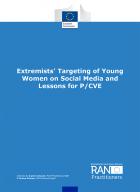Details
- Publication date
- 25 February 2022
- Author
- Directorate-General for Migration and Home Affairs
- RAN Publications Topic
- Gender/women
Description
Over the past decade, the digital sphere has become a growing vector for radicalisation. Much of extremists’ ability to influence public discourse and recruit new members has been due to their adoption of practices and customs of the digital sphere related to gaming culture, social media campaigns and the usage of memes and videos.
The advantages of social media, including low-threshold access, the ability to reach broad potential audiences, limited regulation and a rapid flow of information, have not gone unnoticed by extremist actors. Many groups have transferred their communication, recruitment and propaganda efforts to the digital space.
Extremists’ online presence is not limited to a single platform but is rather a mélange of a large variety of digital spaces and platforms ranging from social media, chatrooms and websites to the darknet ( 1 ). While a few years ago the online recruitment and radicalisation of young men were the main focus of media and preventing and countering violent extremism (P/CVE) actors, this has shifted since the departure of young women and girls to the former territories of Daesh following online radicalisation and targeted grooming efforts.
A recent RAN conclusion paper on young women’s usage of social media discussed extremists’ digital recruitment tactics and vulnerabilities of girls and young women ( 2 ). Identified vulnerabilities included experiences of on- and offline discrimination, a longing for online “sisterhood” with like-minded peers, as well as questions related to insecurity and (developing) sexuality.
While the following paper will also briefly touch upon potential susceptibilities of girls and young women, the main focus will be on how extremist actors target and recruit female and primarily young users on social media. In the first part of the paper, extremists’ activities on different social media platforms are discussed.
The paper will further explore which narratives and strategies are used by right-wing (RWE) and Islamist extremist (IE) actors to lure and recruit young women and girls to (violent) extremism. In a second step, implications for P/CVE are identified in order to better prevent and counter extremists’ online targeting of women and girls.

